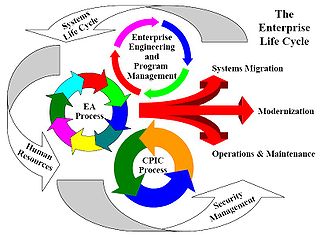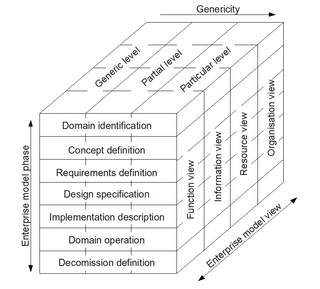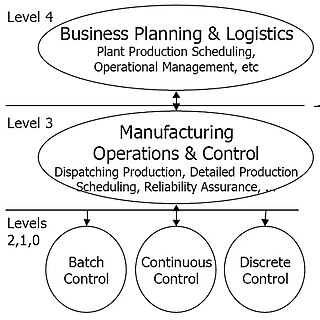Related Research Articles

CIMOSA, standing for "Computer Integrated Manufacturing Open System Architecture", is an enterprise modeling framework, which aims to support the enterprise integration of machines, computers and people. The framework is based on the system life cycle concept, and offers a modelling language, methodology and supporting technology to support these goals.

Enterprise integration is a technical field of enterprise architecture, which is focused on the study of topics such as system interconnection, electronic data interchange, product data exchange and distributed computing environments.
A reference architecture in the field of software architecture or enterprise architecture provides a template solution for an architecture for a particular domain. It also provides a common vocabulary with which to discuss implementations, often with the aim to stress commonality. A software reference architecture is a software architecture where the structures and respective elements and relations provide templates for concrete architectures in a particular domain or in a family of software systems.

An enterprise architecture framework defines how to create and use an enterprise architecture. An architecture framework provides principles and practices for creating and using the architecture description of a system. It structures architects' thinking by dividing the architecture description into domains, layers, or views, and offers models – typically matrices and diagrams – for documenting each view. This allows for making systemic design decisions on all the components of the system and making long-term decisions around new design requirements, sustainability, and support.
The first version of the Enterprise Collaboration Architecture (ECA) has been published by the Object Management Group (OMG) in 2001. The vision of the (ECA) is to simplify the development of component based and services oriented systems by providing a modeling framework aligned with the model-driven architecture (MDA) of the Object Management Group (OMG).
Enterprise engineering is the body of knowledge, principles, and practices used to design all or part of an enterprise. An enterprise is a complex socio-technical system that comprises people, information, and technology that interact with each other and their environment in support of a common mission. One definition is: "an enterprise life-cycle oriented discipline for the identification, design, and implementation of enterprises and their continuous evolution", supported by enterprise modelling. The discipline examines each aspect of the enterprise, including business processes, information flows, material flows, and organizational structure. Enterprise engineering may focus on the design of the enterprise as a whole, or on the design and integration of certain business components.

Enterprise life cycle (ELC) in enterprise architecture is the dynamic, iterative process of changing the enterprise over time by incorporating new business processes, new technology, and new capabilities, as well as maintenance, disposition and disposal of existing elements of the enterprise.

Generalised Enterprise Reference Architecture and Methodology (GERAM) is a generalised enterprise architecture framework for enterprise integration and business process engineering. It identifies the set of components recommended for use in enterprise engineering.
François B. Vernadat is a French and Canadian computer scientist, who has contributed to Enterprise Modelling, Enterprise Integration and Networking over the last 40 years specialising in Enterprise Architectures, business process modelling, information systems design and analysis, systems integration and interoperability and systems analysis using Petri nets.

James G. "Jim" Nell is an American engineer. He was the principal investigator of the Manufacturing Enterprise Integration Project at the National Institute of Standards and Technology (NIST), and is known for his work on enterprise integration.

ISO 19439:2006 Enterprise integration—Framework for enterprise modelling, is an international standard for enterprise modelling and enterprise integration developed by the International Organization for Standardization, based on CIMOSA and GERAM.
Enterprise interoperability is the ability of an enterprise—a company or other large organization—to functionally link activities, such as product design, supply chains, manufacturing, in an efficient and competitive way.
Model Driven Interoperability (MDI) is a methodological framework, which provides a conceptual and technical support to make interoperable enterprises using ontologies and semantic annotations, following model driven development (MDD) principles.
Mark Stephen Fox is a Canadian computer scientist, Professor of Industrial Engineering and Distinguished Professor of Urban Systems Engineering at the University of Toronto, known for the development of Constraint Directed Scheduling in the 1980s and the TOVE Project to develop an ontological framework for enterprise modeling and enterprise integration in the 1990s.
Kurt Kosanke is a German engineer, retired IBM manager, director of the AMICE Consortium and consultant, known for his work in the field of enterprise engineering, Enterprise integration and CIMOSA.

Purdue Enterprise Reference Architecture (PERA), or the Purdue model, is a 1990s reference model for enterprise architecture, developed by Theodore J. Williams and members of the Industry-Purdue University Consortium for Computer Integrated Manufacturing.
Theodore Joseph Williams was an American engineer and Professor of Engineering at Purdue University, known for the development of the Purdue Enterprise Reference Architecture.
Guy Doumeingts is a French engineer, Emeritus professor at the University of Bordeaux 1 and former Director of "Laboratoire d’Automatique, Productique Signal et Image" control theory, known for the development of the GRAI method and his contributions to the field of Enterprise modelling.
Bruno Vallespir is a French engineer, and Professor of Enterprise Modelling at the University of Bordeaux, working in the fields of production management, performance evaluation and enterprise modeling.
The history of business architecture has its origins in the 1980s. In the next decades business architecture has developed into a discipline of "cross-organizational design of the business as a whole" closely related to enterprise architecture. The concept of business architecture has been proposed as a blueprint of the enterprise, as a business strategy, and also as the representation of a business design.
References
- 1 2 Peter Bernus. Accessed 10 January 2009.
- 1 2 3 4 Short bio. Accessed 10 January 2009
- 1 2 J.G. Nell (2006). "Requirements and Methodology for Enterprise-Reference Architectures: A New Work Item Proposal". updated 20 May 1996.
- ↑ Generalised Enterprise Reference Architecture and Methodology. Version 1.6.3 (March 1999). Accessed 10 January 2009.
- ↑ Deborah J. Nightingale and Donna H. Rhodes (2004) "Enterprise Systems Architecting: Emerging Art and Science within Engineering Systems". MIT Engineering systems symposium 2004. p. 2
- ↑ Peter Bernus, Laszlo Nemes and Günter Schmidt (ed.) (2003). Handbook on enterprise architecture.
- ↑ Richard A. Martin et al (2004) "Architectural Principles for Enterprise Frameworks: Guidance for Interoperability". ICEIMT 2004. p. 4
- ↑ Peter Bernus at DBLP Bibliography Server
- ↑ Peter Bernus publications indexed by Google Scholar